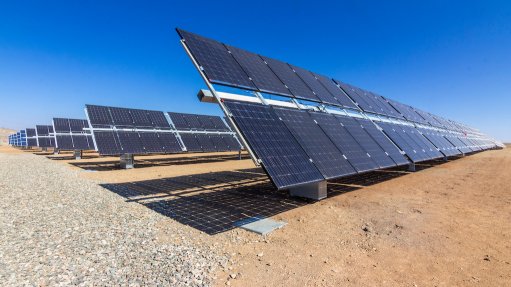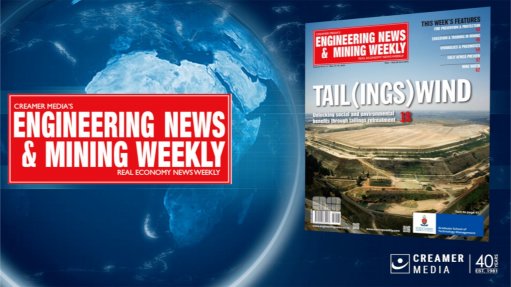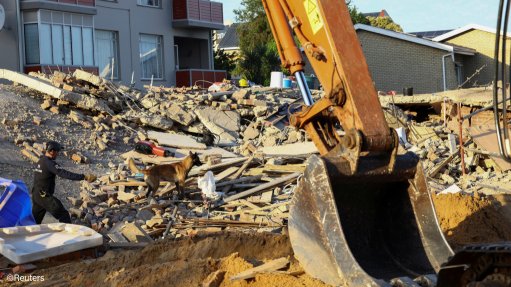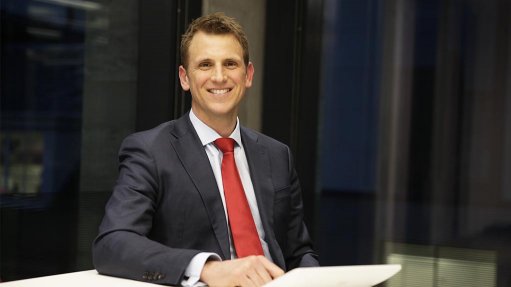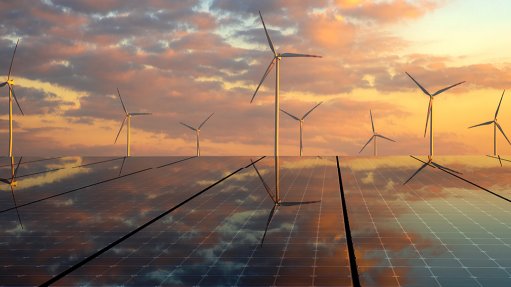Energy poverty unemployment and growth
This article has been supplied as a media statement and is not written by Creamer Media. It may be available only for a limited time on this website.
This opinion piece Rob Jeffrey argues that the South African economy cannot afford to restructure its economy and industry towards renewable energy, nor can it afford the other structural changes this implies.
By Rob Jeffrey
The recent discussion about energy and electricity is one of the most important debates South Africa can have. One of the fundamental objective of South Africa is the necessity to address urgently inequality unemployment and poverty and this objective cannot be achieved by redistribution of wealth alone. It can only be achieved by raising the economic growth rate. A higher growth rate is dependent on having the correct public policies in place and having an adequate and growing supply of affordable electricity. This article covers the latter aspect. In order to ensure economic growth, South Africa must develop its industrial base and it is therefore essential to supply electricity at the lowest possible cost.
Renewables
The first major issue raised by the CEO of Eskom in this debate concerns renewables. He has accurately described the fallacy and weakness of the primary renewables, wind and solar. These are highly variable, often supplying power when it is not needed and not supplying power when it is needed. As a result, these are expensive forms of energy production, yet the supply must be bought in terms of the purchase agreements at set prices. This has been the experience in Germany under their energiewende programme.
Germany sells unwanted electricity at a loss to other countries and purchases the required supply from other countries at a premium. These prices are in effect financial subsidies for wind and solar. In Germany, they are fortunate that they have other major electricity generating countries nearby.
They can tap into electricity provided by nuclear power plants in France, coal-generated electricity in Poland or hydro-electricity from Scandinavia; South Africa is not in that enviable position. Because of all the financial subsidies, Germany has by far the most expensive industrial and household electricity in Europe. They have now capped the supply of renewables and are in the process of terminating all financial subsidies to renewable companies. What energiewende has clearly established is that wind energy and solar CSP are not technologies suitable for mass electricity supply.
This theme has been repeated in other countries such as South Australia where their wind energy drive is a case in point and echoes what has happened in Germany. A view of the literature on energiewende, wind in South Australia and growing energy poverty in industrialised and developed economies are compulsory reading for all interested in the energy field.
Of concern are plans to introduce massive windfarms spread across South Africa for between 30GW and 60 GW of wind turbines. It is deemed that geographically separated windfarms will ensure a more continuous supply of electricity. This theoretical but unproven view is that somewhere in the country, the wind is blowing and the sun is shining. This is not the experience of Europe and the UK where the average load factor from all onshore wind farms remains less than 30%.
Even allowing for better wind delivery, electricity generation is still not certain all the time and one would still need to have full back-up for base load power when delivery does not occur. A full delivery plan would require more than 6000 square kilometres of unsightly windfarms generally built on high ground to ensure maximum efficiency, requiring more than 12,000 Kilometres of roads to service each unit. In addition, the landscape of the countryside would be criss-crossed by at least 10,000 kilometres of additional transmission lines. This is a potential environmental catastrophe, not only would there be damage to the local habitat, but the damage to insect, bird, bat and other flying life does not bear thinking about.
It is a known fact that large birds such as vultures and eagles, but also other bird life cover large areas while hunting and feeding, they are particularly vulnerable to windfarms. The facts from Europe and America indicate that the plans will in effect decimate large numbers and areas of larger birds while the impact on bird migration could also be catastrophic. Environmentalists need to take note of the habitat, ecological and environmental disaster that is in the planning stages.
Nuclear
The second major issue raised by Eskom concerned nuclear. The CEO of Eskom stated that baseload should be provided by coal and nuclear, presumably including other fossil fuels primarily gas. The question remains how much nuclear? Nuclear power stations take ten years to build, and the upfront costs make a large build programme unaffordable for a country like South Africa. As an example, Britain is relooking at the Hinckley Point nuclear power station project.
The total cost for the 3200MW Hinckley Point nuclear power station is approximately R333 billion. This should be compared to the 4800MW Medupi power station costing an estimated R200 billion and the initial, now installed, renewables 2310MW programme costing approximately R170 billion. When one considers that renewables only deliver power 31% of the time, their cost far exceeds nuclear while clean coal fired plants such as Medupi are far less expensive. It is recognised that renewable capital costs have dropped substantially since those early days and are currently far below the initial costs as set out above and guaranteed delivered costs now stand at approximately 66 cents/kWh.
Based on this guaranteed delivered price and a load factor of only 31%, this guaranteed price effectively becomes a subsidised price as it is paid for whether the electricity is required or not. There are increased costs caused by the low load factor on transmission costs and furthermore greater distances are involved. As a result, the true total cost of wind power for delivered power is significantly more expensive than coal-generated electricity and it is also greater than that for nuclear which in turn is also approximately 30% more than equivalent coal fired electricity.
These significantly higher final delivered electricity prices have a significant detrimental impact on the economy. They slow economic growth and devastate the goods-producing industries including the all-important mining, manufacturing, agricultural and agri-processing industries. These industries are key to South Africa’s export performance and employment growth particularly amongst the relatively unskilled working population. It is estimated that there will be 16 million new workers entering the work force in the period up to 2030. With low baseload electricity growth of only 2.5% per annum, GDP growth is unlikely to increase at more than approximately 2.8% per annum. At this growth rate less than 6 million jobs will be created by 2030. In other words unemployment will grow by at least 10 million job seekers.
Independent Power Producers
The third major issue raised concerned the Independent Power Producers (IPP). The point made was that Eskom is going to stop signing new agreements with Independent Power Producers. According to Eskom, the issue concerned the guaranteed prices and offtakes of renewables, not the IPP's themselves.
This is economically and from a business point of view absolutely correct and the concern has broadened to the future role of IPP’s. IPP’s are essential for the future of energy provision and economic development of the economy.
Eskom is already effectively a giant monopoly controlling generation transmission and distribution of the entire market, which cannot be allowed to continue in a market-orientated economy. Eskom already generates, distributes and controls through the grid close to 40,000 MW. By 2035, in less than 20 years, South Africa electricity demand will increase to over 70,000MW (provided the correct economic policies are followed to foster economic growth). The bulk of this electricity growth should be provided by IPP’s. The existence of a mega-monopoly, whether state-controlled or privately-owned, does not make economic or business sense. The structure of Eskom in this process must be addressed.
Eskom should be split into at least two and preferably three stand-alone independent operating companies. A generation company (Genco), a company responsible for the grid transmission and market operations (Gridco) and a distribution company (Disco). Governments everywhere are notoriously poor managers of commercial entities; this government is no exception and the list includes SAA, SABC, Denel and Telkom as just a few examples. These three companies should be set up as three independent public-private partnerships with management firmly in the hand of the private sector.
Genco would need to focus on baseload generation, replacing its aging fleet and limited growth almost certainly using clean coal supported by major gas operations. The structure would allow the IPP’s to flourish and bring in genuine competition free of all subsidies. This must include all generating grid and distribution subsidies. If subsidies are required, for example for distribution and poverty alleviation these must be government funded not company funded. Some difficult political decisions would need to be made but these would have to be brought out into the open.
Environmental
The fourth major issue that looms in the background of every decision regarding energy is the environmental issue and the commitment to COP 21, the outcome of which was an excellent agreement. What was important was not only what was agreed but more important what was not agreed. The agreement gave a set of sound long-term global objectives. In broad structure, the Paris Agreement reflects a “hybrid” approach, blending bottom-up flexibility (to achieve broad participation) with top-down rules, to promote accountability and ambition. Importantly, the agreement asked for no firm commitments by any country. Many provisions establish common goals while allowing flexibility to accommodate different national capacities and circumstances. The reason for an objective or goal without binding obligations was simply that various countries could not get national political agreement internally (the USA) or emerging countries were not going to make any such firm commitments as they either had high levels of poverty or had rich fossil fuel reserves. In summary countries were expected to do what was in their best economic and financial interests.
Energy policies in emerging economies
The emerging countries mentioned above include the ASEAN countries, China, Russia, India, Vietnam, Korea and Poland. Many are in fact embarking on major expansions of coal and fossil fuels. They have determined that clean coal and gas are the cheapest, most efficient and most reliable sources of electricity to achieve their economic growth objectives and in turn poverty reduction, with replacement of aging inefficient power stations a major objective. Clean coal is globally recognised to be one of the most cost-effective and efficient methods of reducing emissions and reducing other pollution.
Prime examples of such clean coal countries include the ten ASEAN countries namely Brunei, Darussalam, Cambodia, Indonesia, Malaysia, Myanmar, Philippines, Singapore, Thailand and Vietnam. In these countries, electricity generation increased by an average of 7.5% per year, from 155.3 TWh in 1990 to 821.1 TWh in 2013. Fossil Fuels generated 79.4% of ASEAN electricity in 2013. Coal-based electricity capacity is projected to increase from about 47GW in 2013 to 261GW in 2035, an average growth rate 8.1%. In Vietnam, GDP growth is expected to average 6.0 % per annum between 2015 and 2030. Coal generation will increase from 36% of electricity generation to 56% increasing at 7.2% per annum. All these groups of countries have experienced growth at over 5% and are planning for at least that growth in the next 15 years. South Korea expects growth in its power sector of 3.6%, the major proportion of which will be coal and gas. In Poland growth is expected to be primarily in coal.
Piyush Goyal, Minister of State with Independent Charge for Power, Coal, New and Renewable Energy in the Government of India has been quoted as saying “We will be expanding our coal-based thermal power. That is our baseload power. All renewables are intermittent. Renewables have not provided baseload power for anyone in the world” It is not surprising therefore that in India annual average electricity demand between 2000–2013 grew from 376 TWh to 897 TWh - most of it coal based. Coal fired electricity is forecast to grow at over 4% per annum from approximately 166GW to 500GW.
In comparison, the average growth in ‘Electricity available for distribution in South Africa’ as measured by StatsSA grew an average of only 1.7% during 1990 and 2015. Average GDP growth was 2.5% during the same period. Even worse, average electricity demand growth from 2000 to 2015 has averaged only 1.3% per annum. Over this period, the average GDP was 3.1% per annum. This higher growth was due to excessive growth in the services sector, primarily in the public and government sectors, but poor mining and manufacturing sector growth. The equivalent figures for the period 2008 to 2015 were electricity supply growth of only approximately 1.1% per annum and GDP growth of only 1.9% per annum. It is little wonder that South African GDP growth does not parallel the other emerging economies. In terms of the IRP, electricity growth between 2015 and 2030 appears to be approximately 3.9%. However, because of the low load factors of renewables, real deliverable baseload electricity growth will be only 2.5% per annum. As a result, future average growth to 2030 is unlikely to average more than 2.7% per annum.
The way forward
Unfortunately, the problems of economic growth involve both policy issues and energy issues. South Africa is facing slow growth and lack of both domestic and foreign investment primarily in the mining and manufacturing industries. From a policy point of view, public policies need to change radically to make South Africa (a treasure chest of minerals) attractive to such investment again. Planning for low baseload electricity growth is a self-fulfilling prophesy. Industrialised countries and their leaders need to recognise that the needs and requirements for emerging and developing economies are very different from their own. They should not force their own standards onto these economies.
Emerging markets need secure base load electricity power at the lowest possible cost by fully utilising the natural resources that give them a comparative economic advantage, whether that natural resource be oil, hydroelectricity, or a fossil fuel such as coal or gas. The developed world needs to recognise that at this stage of technological development, fossil fuels in the form of gas and coal will continue to play a substantial role in providing the country’s major energy source. In a speech earlier this year, President Obama has himself acknowledged that emerging economies such as India China and the ASEAN countries be building coal-fired power stations would out of necessity but they should use clean coal technology.
It is time for South Africa to break away from the vested idealistic or financial interest driving the large renewable expansion schemes. They are not the panacea for the country’s future energy problems and growth. The CEO of Eskom was correct in saying that baseload electricity should be provided by coal and nuclear. They are the only sources of energy that can provide security of base load electricity supply at internationally competitive prices. The fact that nuclear is capital-intensive upfront means that South Africa cannot afford a major investment in nuclear as the way forward. Nevertheless, if procurement goes ahead, it should be no more than 1800 MW and a maximum of 3200MW.
The South African economy cannot afford to restructure its economy and industry towards renewable energy nor can it afford the other structural changes this implies, either now or in the foreseeable future. Such a move will only increase uncertainty and further reduce long-term domestic and foreign investment. Renewable policies are poised to take South Africa in the wrong economic direction, i.e., slow economic growth and increased unemployment.
The cost and burden of such plans always fall on the poor in terms of high unemployment and increasing poverty. South Africa needs to follow the lead of other emerging nations that are increasingly using coal and gas to pursue higher growth. Energy, electricity and employment growth are the keys to South Africa’s future economic, social and political prosperity, sustainability and stability. It is time to put South Africa first.
Jeffrey wrote this article in his personal capacity
Comments
Press Office
Announcements
What's On
Subscribe to improve your user experience...
Option 1 (equivalent of R125 a month):
Receive a weekly copy of Creamer Media's Engineering News & Mining Weekly magazine
(print copy for those in South Africa and e-magazine for those outside of South Africa)
Receive daily email newsletters
Access to full search results
Access archive of magazine back copies
Access to Projects in Progress
Access to ONE Research Report of your choice in PDF format
Option 2 (equivalent of R375 a month):
All benefits from Option 1
PLUS
Access to Creamer Media's Research Channel Africa for ALL Research Reports, in PDF format, on various industrial and mining sectors
including Electricity; Water; Energy Transition; Hydrogen; Roads, Rail and Ports; Coal; Gold; Platinum; Battery Metals; etc.
Already a subscriber?
Forgotten your password?
Receive weekly copy of Creamer Media's Engineering News & Mining Weekly magazine (print copy for those in South Africa and e-magazine for those outside of South Africa)
➕
Recieve daily email newsletters
➕
Access to full search results
➕
Access archive of magazine back copies
➕
Access to Projects in Progress
➕
Access to ONE Research Report of your choice in PDF format
RESEARCH CHANNEL AFRICA
R4500 (equivalent of R375 a month)
SUBSCRIBEAll benefits from Option 1
➕
Access to Creamer Media's Research Channel Africa for ALL Research Reports on various industrial and mining sectors, in PDF format, including on:
Electricity
➕
Water
➕
Energy Transition
➕
Hydrogen
➕
Roads, Rail and Ports
➕
Coal
➕
Gold
➕
Platinum
➕
Battery Metals
➕
etc.
Receive all benefits from Option 1 or Option 2 delivered to numerous people at your company
➕
Multiple User names and Passwords for simultaneous log-ins
➕
Intranet integration access to all in your organisation







